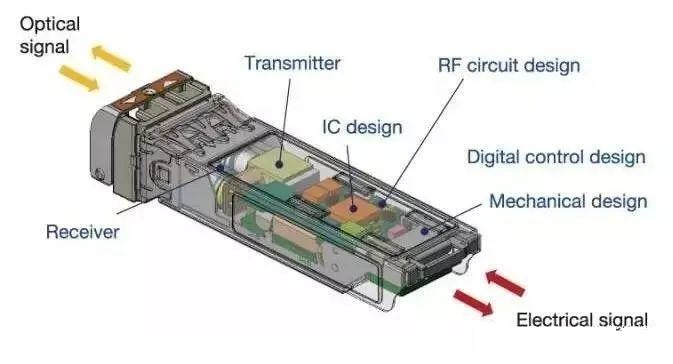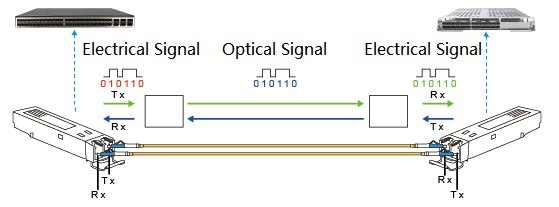Learn About Optical Transceiver Modules in One Minute
2023-05-19
An optical transceiver module is a photoelectric conversion accessory and one of the key devices in the field of optical communication transmission. It is composed of optoelectronic devices, functional circuits and optical interfaces, etc.

Structure
In addition to the common transceiver integrated optical module, according to the needs of some special scenarios, the optical module has also derived some other structures. For example, for scenarios that only need to receive optical signals, the optical module only needs a receiver, so there are single-receiver modules and double-receiver modules ; For scenarios that only need to transmit optical signals, the optical module only needs the transmitter, so there are single light-emitting module and double light-emitting module.
Working Principle
The optical transceiver module works at the physical layer of the OSI model and is one of the key components in the optical fiber communication system. It is mainly composed of optoelectronic devices (optical transmitters, optical receivers), functional circuits, and optical interfaces. Its main function is to realize the photoelectric conversion and electro-optical conversion functions in optical fiber communication.
The sending interface inputs an electrical signal with a certain code rate, and after being processed by the internal driver chip, the modulated optical signal of the corresponding rate is emitted by the driving semiconductor laser (LD) or light-emitting diode (LED). After transmission through the optical fiber, the receiving interface transmits the optical signal It is converted into an electrical signal by a photodetector diode, and an electrical signal of a corresponding code rate is output after passing through a preamplifier.

BiDi Optical Transceiver Module
The transmitter and receiver are as a whole, and one device can be used as both a transmitter and a receiver. The signal transmission of this optical transceiver module can realize bidirectional transmission through a single optical fiber.
Compact SFP Optical Transceiver Module
If two identical devices are installed inside the single-fiber bidirectional optical module, then two channels of signal transmission can be performed at the same time.
Role of Optical Transceiver Module
The optical module is a carrier used for transmission between the switch and the equipment. It is a connection module that acts as a photoelectric conversion. The sending end converts the electrical signal into an optical signal. After transmission through the optical fiber, the receiving end converts the optical signal into an electrical signal Signal.
Type of Optical Transceiver Modules
There are five types of optical module packages: SFP, SFP+, SFP28, QSFP+ and QSFP28, and the speed rates are 100M/1000M, 10G, 25G, 40G, 100G.
| Type | Data Rate | Transmission Distance | Applications |
| SFP | 100Mbps/1000Mbps | 100m~40km | Ethernet, Gigabit Ethernet, SDH, SONET, Fiber Channel |
| SFP+ | 10Gbps | 30m~100km | 10G Ethernet, 8.5G Fiber Channel, SDH, SONET |
| SFP28 | 25Gbps | 100m~40km | 25G Ethernet, 32G Fiber Channel |
| QSFP+ | 40Gbps | 100m~40km | 40G Ethernet |
| QSFP28 | 100Gbps | 100m~80km | 100G Ethernet, Data Centers |
Application Scenarios
Data Centers
There are lots of network switches, servers, etc in the main equipment room of the data center. They are the core of integrated wiring and information network equipment, and are also the data aggregation center of the information network system. The connection between servers, between switches, and between servers and switches requires the use of optical modules (direct-connected copper cables, active optical cables), fiber patch cables, and other transmission carriers to achieve data exchange.
Base Station
The base station of operator also needs optical transceiver modules to realize the interconnection between RRU and BBU devices. In the application, it needs to connect the links between these two devices, which requires optical transceiver modules and fiber patch cables. In 4G network, the devices used to connect the BBU and RRU are mainly 1.25G, 2.5G, 6G, 8G and 10G optical transceiver modules.
5G Bearer Network
The advent of the 5G era has indeed brought a new round of growth space to the optical module industry. The 5G bearer network is generally divided into metropolitan access layer, metropolitan convergence layer and metropolitan core layer to realize fronthaul and midhaul functions of 5G services. Among them, the interconnection between the devices of each layer mainly depends on the optical module.
Passive WDM System
Passive WDM systems are mainly used in metropolitan area networks, backbone networks, and wide area networks. CWDM optical transceiver modules and DWDM optical transceiver modules are commonly used. The CWDM optical module adopts CWDM technology, which can combine optical signals of different wavelengths through an external wavelength division multiplexer and transmit them through a single optical fiber, thereby saving optical fiber resources. At the same time, the receiving end needs to use a wave division multiplexer to decompose the complex optical signal.







